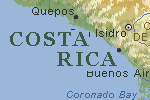Main menu:
Costa Rica
Introduction |
||||||
Flag: |
|
|||||
Card: |
||||||
Location: |
Costa Rica is a Central American success story: since the late 19th century, only two brief periods of violence have marred its democratic development. Although still a largely agricultural country, it has achieved a relatively high standard of living. Land ownership is widespread. Tourism is a rapidly expanding industry. |
|||||
Geography |
||||||
Position: |
Middle America, bordering both the Caribbean Sea and the North Pacific Ocean, between Nicaragua and Panama |
|||||
Geographic coordinates: |
10° 00' N, 84° 00' W |
|||||
Bereich: |
Gesamtmenge: 51.100 Quadrat-Kilometer |
|||||
Map references: |
Central America and the Caribbean |
|||||
Area: |
total: 51,100 sq km |
|||||
Map references: |
Gesamtmenge: 639 Kilometer |
|||||
Land boundaries: |
total: 639 km |
|||||
Coastline: |
1,290 km |
|||||
Maritime claims: |
exclusive economic zone: 200 NM |
|||||
Climate: |
tropical and subtropical; dry season (December to April); rainy season (May to November); cooler in highlands |
|||||
Terrain: |
coastal plains separated by rugged mountains |
|||||
Elevation extremes: |
lowest point: Pacific Ocean 0 m |
|||||
People |
||||||
Population: |
3,773,057 (July 2001 est.) |
|||||
Nationality: |
noun: Costa Rican(s) |
|||||
Ethnic groups: |
white (including mestizo) 94%, black 3%, Amerindian 1%, Chinese 1%, other 1% |
|||||
Religions: |
Roman Catholic 76.3%, Evangelical 13.7%, other Protestant 0.7%, Jehovah's Witnesses 1.3%, other 4.8%, none 3.2% |
|||||
Languages: |
Spanish (official), English spoken around Puerto Limon |
|||||
Government |
||||||
Country name: |
conventional long form: Republic of Costa Rica |
|||||
Government type: |
democratic republic |
|||||
Capital: |
San Jose |
|||||
Administrative divisions: |
7 provinces (provincias, singular - provincia); Alajuela, Cartago, Guanacaste, Heredia, Limon, Puntarenas, San Jose |
|||||
Independence: |
15 September 1821 (from Spain) |
|||||
National holiday: |
Independence Day, 15 September (1821) |
|||||
Flag description: |
five horizontal bands of blue (top), white, red (double width), white, and blue, with the coat of arms in a white disk on the hoist side of the red band |
|||||
Regierungsart: |
demokratische Republik |
|||||
Hauptstadt: |
San Jose |
|||||
Economy |
||||||
Economy - overview: |
Costa Rica's basically stable economy depends on tourism, agriculture, and electronics exports. Poverty has been substantially reduced over the past 15 years, and a strong social safety net has been put into place. Foreign investors remain attracted by the country's political stability and high education levels, and tourism continues to bring in foreign exchange. However, traditional export sectors have not kept pace. Low coffee prices and an overabundance of bananas have hurt the agricultural sector. The government continues to grapple with its large deficit and massive internal debt and with the need to modernize the state-owned electricity and telecommunications sector. |
|||||
Industries: |
microprocessors, food processing, textiles and clothing, construction materials, fertilizer, plastic products |
|||||
Industrial production growth rate: |
4.3% (2000) |
|||||
Electricity - production: |
5.805 billion kWh (1999) |
|||||
Agriculture - products: |
coffee, pineapples, bananas, sugar, corn, rice, beans, potatoes; beef; timber |
|||||
Exports: |
$6.1 billion (f.o.b., 2000 est.) |
|||||
Exports - commodities: |
coffee, bananas, sugar; pineapples; textiles, electronic components, medical equipment |
|||||
Currency: |
Costa Rican colon (CRC) |
|||||
Currency code: |
CRC |
|||||
Ports and harbors: |
Caldera, Golfito, Moin, Puerto Limon, Puerto Quepos, Puntarenas |
|||||
Coffee |
||||||
Costa Rica hard bean, european preparation |
Clean cup, high medium acidity and body, altitute 1200/1500 m. |
|||||
Classifications: |
Region |
Altitude |
Quality |
Harvest Season |
Cup |
|
|
1200-1700 |
|
|
high fine acidity |
||
Heredia |
1200-1500 |
SHB |
Dez. - March |
high fine acidity |
||
Palmares |
1100-1250 |
Good Hard Bean |
Dez. - March |
high fine acidity |
||
San Jose |
900-1100 |
Hard bean |
Nov. - Feb. |
good acidity |
||
Orosi |
800-1200 |
High Grown Atlatic |
Aug. - Jan. |
normal acidity |
||
Can a coffee be |
That's the criticism leveled at the coffees from Costa Rica - too balanced, too clean. But there's a lot more to Costa Rican than that. They are prized for their high notes: bright citrus or berry-like flavours in the acidity ...and in the best cups they fade into chocolate or spice flavour in the aftertaste... |
|||||
Port of Export: |
Puerto Limon, Puntarenas, Caldera, Golfito |
|||||
Shipment: |
in container in bags (275 bags of each 69,- kos net) |
|||||
Production: |
2.188.000 bags |
|||||
Export figures: |
1.643.810 bags |
|||||
Caffeine content: |
1.22 / 1.45 % |
|||||












